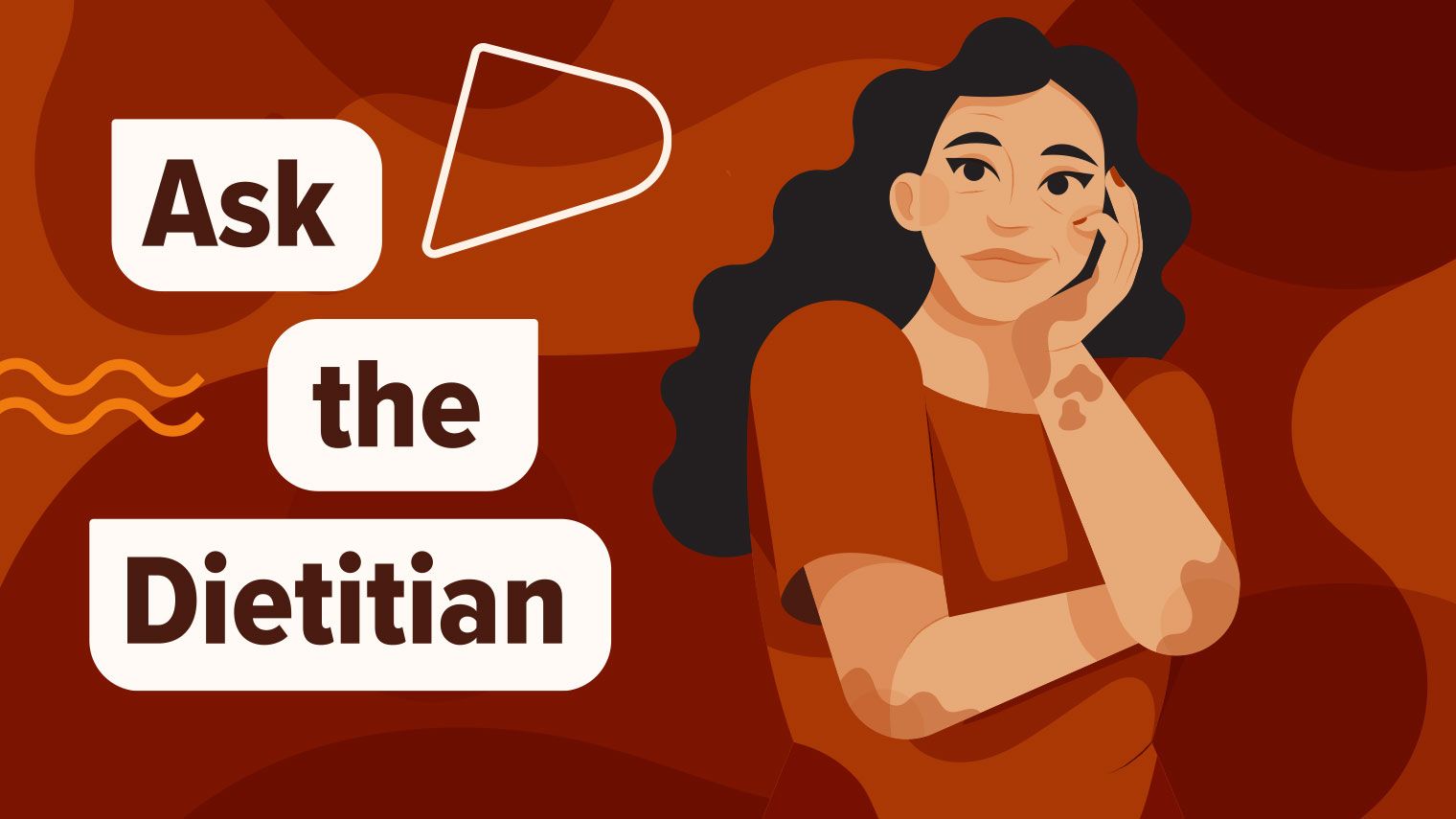Ask a Dietitian: What Does It Mean to ‘Eat Healthy’ When You Live with PsA?
May 31, 2022
Content created for the Bezzy community and sponsored by our partners. Learn More

Collage design by Ryan Hamsher
Laura Krebs-Holm, a dietitian living with psoriatic arthritis, answers questions from Bezzy PsA community members.
When people are diagnosed with psoriatic arthritis (PsA), their doctor will likely discuss medication options, symptom management, pain relief, and even exercise options. Some doctors may advise patients to “eat a healthy diet,” but it can be hard to know what a “healthy diet” looks like for someone living with PsA.
Here are answers to questions asked by Bezzy PsA community members.
Q: What are “good foods” to eat for PsA?
Research points to the benefits of eating an anti-inflammatory diet for people living with PsA. Foods rich in antioxidants and omega-3 fatty acids are anti-inflammatory, and that is a long list of foods.
Whole grains, fruits, vegetables, poultry, fish, olive oil, avocados, and nuts are great anti-inflammatory options for many people. Limiting red meats, highly processed foods, refined grains, sweets, and alcohol can also be helpful. Some people find that eliminating dairy also helps reduce PsA symptoms.
There is some evidence about the benefits of the Mediterranean diet with PsA and psoriasis, but not enough to recommend it broadly.
However, the Mediterranean diet is rich in anti-inflammatory ingredients, so if you are looking for a place to start, it can be a good choice. I was following a Mediterranean diet but had to cut out gluten. I found that combination worked well for me.
That said, I often remind people that many of the reasons the Mediterranean diet is anti-inflammatory apply to other cuisines, too. Indian food incorporates a lot of plants, grains, legumes, and very powerful spices. Many East Asian cuisines are also plant-rich and include a lot of fish.
Next time you feel like you are in a “recipe rut,” try opting for a new Japanese or Chinese recipe.
Q: Are there common trigger foods that I should avoid if I have PsA?
This is a great question with a complicated answer. There isn’t a definitive list of foods that trigger PsA for every person.
Trigger foods vary person to person. Some common triggers include sugar, saturated and trans fats, alcohol, and for some, dairy.
Strategies like keeping a food journal or removing one food from your diet for a period of time can help you figure out how specific foods impact your PsA symptoms.
Q: What are the best fruits to eat for PsA?
Most fruits have anti-inflammatory properties. Apples are high in a natural flavonoid called quercetin that is anti-inflammatory and may reduce symptoms caused by autoimmune diseases like PsA. Berries are also antioxidant powerhouses. Fruits rich in vitamin C have great health benefits, too.
I mean, honestly, all fruits are great.
Q: What should I eat if I’m tired and just want to order a pizza?
Eating well doesn’t need to require a lot of work.
Several meal kit delivery services have a Mediterranean diet option now. While these options will likely include anti-inflammatory meals, it is important to consider any other food sensitivities you may have to products like wheat, barley, rye, Parmesan or feta cheeses.
You may be able to make a note of this in your order in many services and these ingredients will be excluded or packaged so that you can dispose or avoid them.
Sunbasket, Home Chef, HelloFresh, and Green Chef are meal kit services that cater to specific meal plans and dietary patterns.
Snap Kitchen also offers many dietary options, but they sell pre-made meals that are delivered to your door. You just have to heat and eat them.
For those days when I am especially busy or really tired, I sometimes order takeout from a local Mediterranean, Indian, or Japanese restaurant.
Another thing that I recommend for flares is keeping items in your freezer and pantry that are easy to prepare.
Salmon burgers, pre-cooked grilled chicken breasts, steam-able frozen veggies, pre-cooked steamed rice or quinoa, or cans of lentil soups can be great to have on hand.
These options will make it easier to throw together a healthy meal in minutes. Quick options can keep you from needing to stand on your feet or grip a knife for long periods of time.
Q: If I’ve been adhering to an anti-inflammatory diet for several months with no improvement, should I continue? All the meal planning is starting to stress me out!
If the stress of meal planning and thinking about food choices is becoming too much, you have to also consider that stress can be a trigger for PsA. Sometimes, it may actually be better for your health to give yourself grace or a break from focusing on eating a certain way.
You can experiment by adding certain foods back into your diet that are convenient, or that you miss, and see how you feel.
Again, this process is very personal and will look different for different people. You may find that adding some foods back is fine, but when you eat too much of a certain food, your symptoms start to flare.
I advise approaching these moments with a spirit of curiosity rather than trying to “sneak” or “cheat” in a certain food. It is, after all, an experiment!


The bottom line
Try not to be hard on yourself. It’s not a fun feeling to enjoy a slice of pizza or an ice cream one night, only to wake up in pain the next morning.
Instead of thinking, “I’ll never be able to eat ice cream again!” try telling yourself, “Right now, ice cream makes me feel bad, but it won’t always be this way. Let’s find another treat to enjoy right now that keeps me feeling as good as possible.”
Be patient with your body and give yourself time. If you are having trouble finding a meal plan that works for you, it can also help to talk to your doctor or a registered dietitian.
Medically reviewed on May 31, 2022
9 Sources


Like the story? React, bookmark, or share below:
Have thoughts or suggestions about this article? Email us at article-feedback@bezzy.com.
About the author